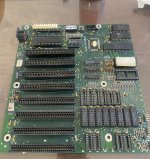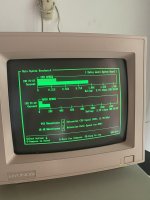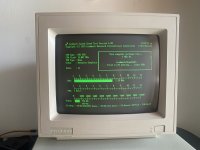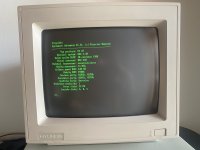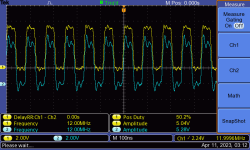Upcoming Events:
- VCF South West - June 14 - 16, Davidson-Gundy Alumni Center at University of Texas at Dallas
- VCF West - Aug 2 - 3, Computer History Museum, Mountain View, CA
- VCF Midwest - Sept 7 - 8 2024, Schaumburg, IL
- VCF SoCal - Mid February 2025, Location TBD, Southern CA
- VCF East - April 2025, Infoage Museum, Wall NJ
-
Please review our updated Terms and Rules here
- Forums
- Companies
- IBM Computers, PCs, Clones and Descendants
- PCs and Clones (XT and early AT class machines)
You are using an out of date browser. It may not display this or other websites correctly.
You should upgrade or use an alternative browser.
You should upgrade or use an alternative browser.
XT motherboard identification
- Thread starter charlysan
- Start date
modem7
10k Member
modem7
10k Member
It could be, but BIOS for that board (fifth entry) looks quite different than mine. I had already checked that list, and none of those boards has a BIOS similar to the one I have. The most similar is `X'GOLDEN TURBO-BOARD`, but PCB layout for that board is totally different.
Last edited:
This is most definitely a Juko ST, though likely a clone such as Flytek ST-12, Unique UX-12 or Auva BXM-12. It's based on the Tamarack TD3300A chipset which, according to the very little amount of documentation I've been able to find is spec'd to run up at 15MHz (though I'm not aware of anyone having ever produced physical evidence that such a board was actually manufactured).
It can take up to 1MB of RAM, however the ASIC does not have proper memory mapping so you are limited to using it with the supplied RAM disk driver or a user-made EMS driver (that is also subject to some of those limitations).
That BIOS is interesting as it is nearly identical to the Juko v2.20, except all of the Juko copyright and branding has been replaced by the string "TURBO XT".
It is definitely a nice XT board and should be quite fast at 12 MHz with that V20. Good score!
It can take up to 1MB of RAM, however the ASIC does not have proper memory mapping so you are limited to using it with the supplied RAM disk driver or a user-made EMS driver (that is also subject to some of those limitations).
That BIOS is interesting as it is nearly identical to the Juko v2.20, except all of the Juko copyright and branding has been replaced by the string "TURBO XT".
It is definitely a nice XT board and should be quite fast at 12 MHz with that V20. Good score!
Thanks @640KB, you are correct. I've just checked and my BIOS is almost identical to Juko v2.20.This is most definitely a Juko ST, though likely a clone such as Flytek ST-12, Unique UX-12 or Auva BXM-12. It's based on the Tamarack TD3300A chipset which, according to the very little amount of documentation I've been able to find is spec'd to run up at 15MHz (though I'm not aware of anyone having ever produced physical evidence that such a board was actually manufactured).
It can take up to 1MB of RAM, however the ASIC does not have proper memory mapping so you are limited to using it with the supplied RAM disk driver or a user-made EMS driver (that is also subject to some of those limitations).
That BIOS is interesting as it is nearly identical to the Juko v2.20, except all of the Juko copyright and branding has been replaced by the string "TURBO XT".
It is definitely a nice XT board and should be quite fast at 12 MHz with that V20. Good score!

I'll by uploading some benchmarks soon. I've already uploaded some stuff related to this board here and here.
Last edited:
vwestlife
Veteran Member
That's an 8 MHz V20 chip. Is the board overclocking it?
I've been running my -8 V20 at 12MHz forever on my own ST-12 and have never had any issues, heat or stability. They seem to overclock quite happily by most accounts.That's an 8 MHz V20 chip. Is the board overclocking it?
Does this board overclock v20 to 12 mhz by default? I don’t see any configuration to accomplish this, besides J3:I've been running my -8 V20 at 12MHz forever on my own ST-12 and have never had any issues, heat or stability. They seem to overclock quite happily by most accounts.
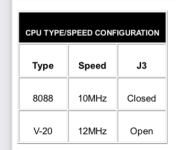
How do you know that the cpu is really running at 12 MHz. Which tool are you using to benchmark?
Love the reverse engineering project on it - would be very interested what you learn, especially with the hardware. I've been studying what I can find about the TD3300A chipset myself to see if there are any hidden capabilities that can be unlocked - such as useful access to the upper memory on board or if there is a way to configure the bus clock to be different than the CPU clock so the board could be run at the 15MHz that it claims it can do. Near as I can tell though, the answer is... no. It appears that the upper RAM can only be bank switched, swapping the 384k of memory that's between 128-512k with the otherwise unused 640-1024k on the board. Unfortunately, there doesn't seem to be any way to map any of it into any real UMA segments, so the utility is limited.
640KB
PS: saw your section about testing with GLaBIOS - very cool. The ST-12 build fully supports TD3300A chipset features like turbo hotkeys and wait state configs -- in fact, the ST-12 is probably my favorite V20 board I own so I've put in a lot of time to tweak it up. Hence the research project to see if there are any possibly useful or even undocumented features that could be worked in to make it even better.
Last edited:
vwestlife
Veteran Member
That's not the CPU's actual clock speed. Landmark is comparing it to the IBM AT and saying the CPU is performing like an AT running at 7.29 MHz.My guess is that 7.29 MHz is the most realistic one.
That's the same result I get on mine on Landmark (7.29) so yours is obviously clocked the same. My experience with benchmark programs that attempt to calculate clock rate is that Landmark 6.0 seems to be the most accurate (at least on XT systems), so I'd tend to trust the "12.087 MHz" as the best confirmation you'll probably get from software.Does this board overclock v20 to 12 mhz by default? I don’t see any configuration to accomplish this, besides J3:
View attachment 1255252
How do you know that the cpu is really running at 12 MHz. Which tool are you using to benchmark?
I have not measured it with a scope, but mine cam with all of the original books and box which all say it is set to 12 MHz "from the factory" and those results are also consistent with others known to be running at 12 MHz... so I'd say it's very safe bet yours is too. I've heard others mention their ST-12s all came with -8 V20's so perhaps NEC had said they could be safely run at that speed.
I believe that CPU type/speed jumper has to do with the fact that the 8088 requires a different duty cycle when it comes to the clock, and 8088's are generally known to not overclock well at all.
@640KB, I'll be happy to help identifying any undocumented feature of TD3300A. Do you know if somebody has fully reversed engineering this BIOS, or has uploaded the original asm source code for ST-12?Love the reverse engineering project on it - would be very interested what you learn, especially with the hardware. I've been studying what I can find about the TD3300A chipset myself to see if there are any hidden capabilities that can be unlocked - such as useful access to the upper memory on board or if there is a way to configure the bus clock to be different than the CPU clock so the board could be run at the 15MHz that it claims it can do. Near as I can tell though, the answer is... no. It appears that the upper RAM can only be bank switched, swapping the 384k of memory that's between 128-512k with the otherwise unused 640-1024k on the board. Unfortunately, there doesn't seem to be any way to map any of it into any real UMA segments, so the utility is limited.
640KB
PS: saw your section about testing with GLaBIOS - very cool. The ST-12 build fully supports TD3300A chipset features like turbo hotkeys and wait state configs -- in fact, the ST-12 is probably my favorite V20 board I own so I've put in a lot of time to tweak it up. Hence the research project to see if there are any possibly useful or even undocumented features that could be worked in to make it even better.
I see. So, that means this CPU is overclocked to 12 MHZ then.That's not the CPU's actual clock speed. Landmark is comparing it to the IBM AT and saying the CPU is performing like an AT running at 7.29 MHz.
Confirmed with scope that CPU is running at 12 Mhz.
Turbo ON:
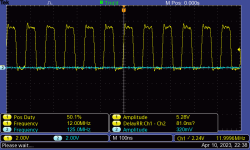
Turbo OFF:
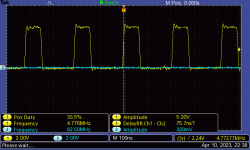
Startup:
View attachment v20_startup_480.mov
Turbo ON:

Turbo OFF:

Startup:
View attachment v20_startup_480.mov
Last edited:
vwestlife
Veteran Member
Now the question is... do the ISA slots run at 12 MHz as well?
BTW @640KB, I've just realized you are the creator of GLaBIOS. I left a question related to TD3300A in the repo. I would like to know how you found out how to setup reg 0x90; if you did that by reverse engineering the BIOS or if you found some documentation that describes this.
I've actually been looking for proper documentation on the TD3300A for quite some time now (including asking recently) and have not come across a true data sheet or programming manual. What I did manage to find was from pieces here and there on forums and guesswork. I can't seem to find the exact post that tipped me off to port 0x90, but the process was really just trial and error working with a very patient tester who had the board, sending test builds back and forth until we figured out exactly what does what. It isn't all that complicated and I documented what I eventually settled on in the source.
The rest of the info I was able to find is basically in the ST-12/UX-12 manual which describes the function of the 0x70 register that controls the wait state. This is also this thread that describes the function (at a high level) of the high memory bank switching register 0xe0. Later on, I came across this post which details all three control registers, and the diagrams were clear enough that it did confirm my findings. I was always hoping there would be more info out there but haven't found any other references that mention anything else.
To answer your question, I actually had neither the data sheet nor had I even had an ST-12 or Juko BIOS at the time to play with. After working with that person who did have one, I realized that this board was really cool and so managed to find one!
If you come across anything else though, please share it. If there's any cool or hidden features that could be added for that board, I'd absolutely do it!
Last edited:

